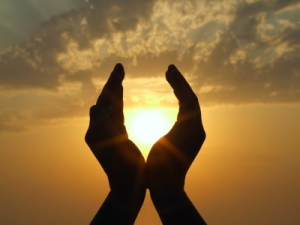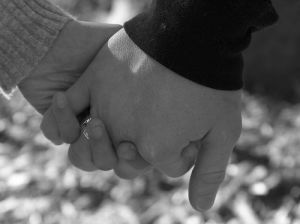Adapted from a drash (spiritual talk) given at Shir Tikvah, Minneapolis, on February 1, 2013.
Shabbat shalom.
Baruch atah Adonai, Eloheinu, Melech haolam, she-asani b’tzelem Elohim.
Sh’ma Israel: Adonai Eloheinu, Adonai Echad.
I invite you to join me in a thought experiment, a little spiritual algebra. I am actually referring literally to mathematics, at least in principle. You may raise your eyebrows a little at this. Go ahead, I’ll wait. And if you knew anything about the trauma I suffered in high school algebra, you’d question my sanity in even bringing the topic up. But it’s the first Shabbat of February, and we are sharing each other’s wonderful company in this holy space, so let’s give it a try.
Every Thursday morning at minyan, where we pray the Shacharit service, we bless the miracles of daily life. One of the most meaningful blessings to me is the one I began with: Baruch atah Adonai, Eloheinu, Melech haolm, she-asani b’tzelem Elohim. Blessed are you God…who made me in the image of God.
A footnote in our siddur Mishkan T’filah informs us that this text “draws on the language of Genesis 1:27: ‘…in the divine image God created humankind.’ [And it goes on to state that] a spark of the divine is implanted in every human being.” (1)
What a powerful idea: God in us. Everyone, no exceptions. Inseparable from our neshama, our soul, our essence. Let me return to algebra for a moment. We are made in the Image of God. We are the Image of God.
A = B
Also on Thursdays mornings, and just a few moments ago, and at bedtime, and for many Jews as they live their final moments, we say the Sh’ma, our creedal statement of monotheism. As we all know by heart, it begins, Sh’ma Israel: Adonai Eloheinu, Adonai Echad. Hear this: God is Our God, God is One.
Echad. One. What does “one” mean? At a minimum, the Sh’ma is a statement affirming monotheism, that there is one god. But what is “one-ness”? In a commentary on the Sh’ma, Rabbi Lawrence Kushner and Rabbi Nehemia Polen cite the teaching of Sheneur Zalman of Liadi (Z”L) the Alter Rebbe of Lubavitch Chasidim. He maintains that nothing exists except God, that any reality beyond God’s voice is an illusion. So beyond being a mere statement of the absolute uniqueness of God, from this perspective the Sh’ma is a statement of “radical monoism…. a declaration of God’s unity, [that] means …[in effect] that nothing exists besides God.” (2)
So, then: God is our God, God is all there is, God is One-ness. Let’s return to our algebra. God is One-ness.
B = C
Somewhere along the way, all of us were taught the Transitive Property: If A = B, and B = C, then A = C. I invite you to take a spiritual leap by asking your left-brain to join for a moment with your soul.
B’tzelem Elohim. If we are the image of God.
And Adonai Echad, God is One-ness,
Then each of us is connected to God’s creation and, through the divine image of God that is woven into our souls, to each other. To everyone. We are one. We are one-ness.
Our tradition teaches that everything is up for debate and discussion. There is no reason you should accept this application of mathematics to any matter of the soul, unless it is meaningful for you.
So to that end, I will close by inviting you to say with me the blessing and prayer that I opened with. And I invite you to ask yourself:
What would it mean if God is in you, and everyone, everywhere?
What would it mean if not only God is one, but also if you and everyone, everywhere are one with God?
Shall we?
Baruch atah Adonai, Eloheinu, Melech haolam, she-asani b’tzelem Elohim.
Sh’ma Israel: Adonai Eloheinu, Adonai Echad.
Echad. One-ness. Shabbat shalom.
Notes
(1) Frischman, Elyse D. (Ed.) Mishkan T’filah: A Reform Siddur: Services for Shabbat. New York: Central Conference of American Rabbis, 2007. 177. Print.
(2) Kushner, Lawrence and Nehmia Polen. “Adonai is One.” The Sh’ma And Its Blessings (My People’s Prayer Book, Vol. 1). Ed. Lawrence A. Hoffman. Woodstock, VT: Jewish Lights Publishing, 1997. 93-94. Print.
Images : Healthapalooza, Yanivba









